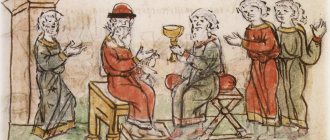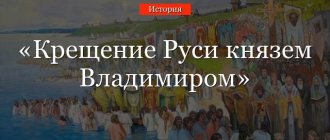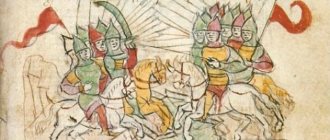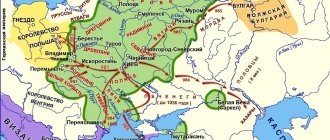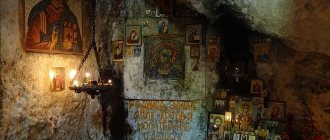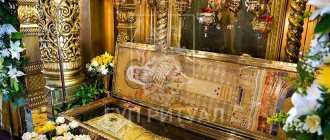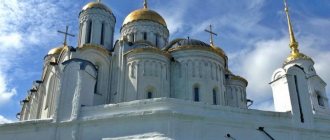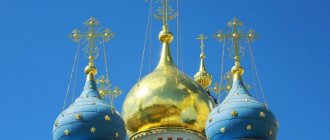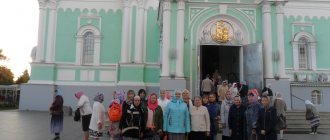The question of where Prince Vladimir was baptized remains controversial today. There are at least three versions of this. Supporters of the first name the place of baptism in Kyiv, the second - the town of Vasilyev, located not far from the first, and the third - Chersonesos. There is also no clear opinion about what year this event occurred. Today we propose to consider the opinion of a scientist, a supporter of one of the most popular versions regarding where Prince Vladimir was baptized.
Why not in Kyiv?
From 1972 to 1984 The Chersonesos expedition took place, organized by the USSR Academy of Sciences. It was headed by archaeologist and historian Sergei Alekseevich Belyaev. It was he who was the author of the scientific discovery associated with the discovery of the font in which Prince Vladimir was baptized. Regarding the opinion that this great event took place in Kyiv, on the banks of the Dnieper, the scientist says the following.
What happened in Kyiv in 988, in August, was already a consequence of the adoption of the Christian faith by Vladimir, which took place a little earlier and in a different place. According to Belyaev, Prince Vladimir was baptized in the city of Chersonese, and this could not have happened anywhere else. This, in particular, is evidenced by The Tale of Bygone Years. It talks about baptism in Korsun - that’s what Chersonesos was called by the Slavs.
Already in the 4th century, during the reign of Emperor Constantine the Great, this Byzantine city was the main Christian center of all Eastern Europe.
The insidious basileus
Emperor Vasily II was in desperate need of military assistance. He was ready to accept it from anyone. Therefore, when the emperor learned about the desire of the Kyiv prince Vladimir to be baptized, he happily expressed a desire to help the Russian prince in this matter. In return, the emperor asked for troops to fight the rebels. Prince Vladimir agreed to help the unfortunate emperor, but in addition to baptism, he demanded that Vasily give him his sister Anna as his wife. The Byzantine basileus agreed. This fact speaks more eloquently than any other about how catastrophic the position of Byzantium was at that moment. After all, the Byzantine autocrats considered themselves heirs of the great Roman Empire. They considered all the sovereigns of the other European powers to be barbarians, unworthy of entering into family relationships with the “porphyry-born” Byzantine princesses. Even when the German king Otto the Great, the creator of the Holy Roman Empire and an extremely influential sovereign in Europe, tried to marry one of the princesses of the Byzantine house, he was rejected with contempt. And here - an unheard of thing! To give as a wife to some “Scythian”, “barbarian prince Vladimir” the emperor’s own sister! Can you think of a greater humiliation? But, as they say, ideals are ideals, and politics are politics! To retain the throne, Vasily II agreed to sacrifice his sister. For Vladimir, this marriage was also least of all a banal arrangement of family life. The wedding with Princess Anne was given purely political significance. If the wife of a Russian prince becomes a representative of the Byzantine ruling dynasty - a dynasty that refuses marriage alliances to French princes and German kings - then one can imagine how much the prestige of the Russian state will rise? After the conclusion of the Russian-Byzantine alliance, Prince Vladimir sent a detachment of 6 thousand soldiers to help the emperor. At that time it was an impressive military force. The combined forces of the Russians and Byzantines defeated the troops of the rebellious Bardas Phocas near Chrysopolis (on the banks of the Bosphorus). Then Russian troops helped the emperor restore his power in all the most remote corners of the empire. Thus, the Byzantine chronograph Yahya of Antioch even mentions the fighting of the Rus as part of the Byzantine army in northern Syria!
Why not somewhere else?
According to Belyaev, this could not have happened anywhere else for the following reasons. The prince's plans were to marry Anna, a Byzantine princess. Before that, he had two legal wives and about 300 concubines. Making a Byzantine princess your wife was a very honorable thing. Judge for yourself. This was denied to the German Emperor Otto himself. And Prince Vladimir succeeded! And the princess was brought from Constantinople to Vladimir in Chersonesus.
For several centuries, Byzantium attracted barbarian tribes into the fold of the Christian Church. In addition, she sought to maintain peace on her own borders. Therefore, Vladimir was a completely suitable party.
But neither the Byzantine emperor nor the patriarch could allow a woman of such high rank to go outside the empire just like that. That is, without being married in a legal Christian marriage according to all church canons. It follows that the question of where to baptize Prince Vladimir and where to get married could only be decided unambiguously - only on the territory of Byzantium, of which Chersonesus was a part.
Byzantium: friend or foe?
The situation at the end of the 10th century was like this. Prince Vladimir defeated his brothers in the internecine struggle that flared up after the death of Prince Svyatoslav in the Pecheneg ambush. The process of disintegration of Rus' into separate principalities was stopped. Rus' became united again. But the victorious prince understood that a unified power needed something more than the pagan beliefs of his ancestors. It is necessary to accept Christianity, and Orthodox Christianity, the kind that is widespread among Rus'’s powerful neighbor, Byzantium. In Byzantium you can find the priests, books, and ritual objects necessary for baptism. But relations with Byzantium at that time were far from ideal. The Byzantines have not yet forgotten how the warlike Prince Svyatoslav shook the foundations of their empire in 970-971. Then, with great difficulty, the Roman power managed to defeat the “Scythian barbarian”, who intended to expel the Byzantines from the Balkan Peninsula. It took the exertion of all the military forces of the empire to oust Svyatoslav across the Danube. And then piles of gold were needed to bribe the Pechenegs and force them to attack the Russian prince, who was returning to Rus' after the campaign. They managed to destroy Svyatoslav, but from then on there was a very hostile attitude towards Rus' in Constantinople. The Byzantine basileus did not want to help the “Scythians” in anything - even in baptism. But at the beginning of the reign of Prince Vladimir, the situation in Byzantium changed. A military rebellion broke out in the empire. First, the commander of the eastern armies of the empire, Varda Sklir, rebelled. To fight him, Emperor Vasily II sent an army under the command of Bardas Phocas. He won, but immediately after it he proclaimed himself emperor. At the beginning of 988, rebel troops approached the Byzantine capital itself, from which they were separated only by the Bosporus Strait. At the same time, the Bulgarian tribes devastated the Byzantine possessions in the west. The position of Byzantium was critical.
How did Vladimir make the decision?
By the time of his marriage to Princess Anna, Vladimir was already ready for baptism. According to the chronicle, back in 986 he raised the question of which faith to choose. He received ambassadors from Volga Bulgaria who offered to convert to Islam, Khazar Jews who invited him to Judaism, and missionaries from the Vatican. But they were all refused. After them, a Byzantine arrived who spoke about the Christian faith.
To find out how rituals were carried out and what laws each religion had, the prince sent ambassadors to worship the Germans, Greeks and Muslims. Ultimately he chose Christianity.
At first, Vladimir relied on paganism
As follows from chronicle sources, in particular from the “Tale of Bygone Years” by the ancient Russian chronicler Nestor, in 980 Vladimir Svyatoslavich tried to carry out a religious reform of paganism. He established a single pantheon of pagan deities. The head of this structure was Perun. It also included Stribog, Dazhdbog, Semarg, Khors and Mokosh.
“Vladimir first tried to strengthen and consolidate paganism. But as an undeniably smart man, he soon realized that this was impossible. Paganism has always led not to the unification of the people, but only to even greater strife between different groups. History has shown that those peoples who remained pagan quickly dissolved into the Christian or Islamic world. Or they disappeared altogether - for example, this happened to the Baltic Slavs. Vladimir quickly realized that efforts to consolidate paganism would not be fruitful, and made a historical choice in favor of Orthodoxy, the unification of the entire people and political independence,” says Vsevolod Chaplin, rector of the Moscow Church of St. Theodore the Studite at the Nikitsky Gate, co-founder of the Russian Mission community .
painting “Vladimir the Pagan” / Vasnetsov Victor
What did the font look like?
Understanding the question of where Prince Vladimir was baptized, it will be interesting to find out how this happened. It is assumed that initially the font in which the sacrament was performed was exactly as it was depicted by the artist Vasnetsov in the painting in the Vladimir Cathedral in Kyiv.
In Chersonesos it was carved into the rock; at the moment its depth is 74 centimeters. When it was opened in the 80s of the 19th century, it was discovered that the entire recess was lined with marble. The cross located at the bottom was also lined with marble. Unfortunately, over time, all this splendor was stolen, and today there is a bare rock with a light brown color. The cross has also not survived.
At that time, the baptismal chapel was perceived as an ordinary temple. In the 90s of the 19th century, the assumption that the marble font carved into the rock was exactly the place where Prince Vladimir was baptized was expressed by Alexander Lvovich Bartier, an outstanding Russian engineer. During the Soviet years, Belyaev's expedition explored the monument in its entirety. And from historical, and from archaeological, and from canonical, and from liturgical points of view.
It is now considered proven that it was on the site of the former temple (baptismal chapel), in the found font, that the baptism of Vladimir in Chersonesos took place. After S. A. Belyaev toured all of Europe with a report on this topic, the scientific community accepted this evidence.
Eagle in Russian
Today we cannot help but remember that it was in the Crimea, in Chersonesus (in the Middle Ages - Kherson, Korsun, now Sevastopol), that Prince Vladimir and his retinue were baptized, and then, accompanied by Greek priests, returned to Kyiv and baptized its inhabitants. If we turn to events from the history of the past, then the emergence of Christianity in Chersonesos itself is associated with the preaching of the Apostle Andrew the First-Called. All the legends known to us recognize the ap. Andrew the First-Called as the head of the Black Sea Mission and direct his path from south to north, from Syria to the Tauride Peninsula, where he converted the local population to Christianity. And it can be assumed that his preaching did not remain fruitless here, because thirty years after his mission, Saint Clement, the Pope of Rome, who had been condemned to imprisonment by the Roman emperor Trajan (98-117), arrived in these places, and found here more than two thousand Christians practicing in quarries, cutting and processing stones for delivery to the inner cities of the Roman Empire. The saint founded several churches in Chersonesus and baptized many pagans. The news of the successes of Saint Clement reached the Roman emperor and immediately caused persecution of Christians, during which the archpastor himself suffered martyrdom, being drowned in the sea (early 2nd century), [Russian Orthodox Church/Orthodox Encyclopedia. - M., 2000. - P. 35].
Due to persecution in the next two centuries, until the beginning of the 4th century, the Christian faith in Chersonesus was mainly adhered to by those exiled for the faith and their descendants. After Emperor Constantine issued an edict in 313, which allowed religious tolerance towards the Christian religion, the Kherson diocese was established. During the reign of Constantine the Great, the diocese of Kherson included the southern Crimea to Feodosia and further to the east, where the Scythians, Taurians and other barbarian peoples lived. At the beginning of the 3rd century, the Goths penetrated into Crimea, and at the end of the 4th century. The Huns invade.
It is known that the Goths adopted Christianity, their bishop Theophilus was present at the First Ecumenical Council (in 325), the acts of which were signed by the Metropolitan of Gothia or, as in other lists, Theophilus of Bosporitania from Gothia [Makariy (Bulgakov). History of the Russian Church. Book 1. - M., 1994. - P. 115]. The Goths who remained after Theodoric left for Italy were surrounded on all sides by the Huns, with whom they tried to maintain friendly relations until around the beginning of the 8th century. were not conquered by the Khazars. In addition to the above-mentioned dioceses, on the territory of the Crimean Peninsula and adjacent lands, the Sourozh, Fulla and Bosporan dioceses were formed, in which not only Greek settlers lived, but also the Sarmatians, whose kings ruled the Bosporan kingdom until the end of the 4th century, the capital of which was Panticapaeum, or Bosporus , where Kerch is now.
The Huns settled from the Bosporus to Chersonesus until at the end of the 7th century they were conquered by the Khazars, who, however, did not want to move to Crimea, remaining in southern Russia, beyond the Don and on the coast of the Caspian Sea. At the same time, history testifies to cases when the Huns and other barbarians living in Crimea converted to Christianity [Ibid. - P. 125-127]. There is no doubt that at different periods of the history of Crimea the Christian faith did not dry out and always found its followers, as evidenced by archaeological excavations of Greek cities on the southern coast. As a result of excavations on the territory of Kherson, 13 basilicas, 2 buildings of centric composition, 5 cruciform, 7 cross-domed churches and about 20 relatively small quarterly temples of chapels from the 11th-15th centuries were discovered. [Russian Orthodox Church/Orthodox Encyclopedia. - P. 36].
As researchers note, intensive construction of churches and monasteries in Crimea, and in particular in Kherson and its suburbs, began under the Byzantine emperor Justinian I (527-565). Archaeological evidence - crypts with paintings depicting vines or fish, tombstones with images of crosses, Christian sculptures - suggests widespread Christianization of the population of Kherson during this period.
During the time of iconoclasm, in the middle of the 8th century, many admirers of icons, mostly monks, fled to Crimea to escape the persecution of the Byzantine emperor, due to which the number of cave monasteries increased in the territory of South-Western Crimea. For many centuries, Kherson played the role of a center of missionary and cultural influence on neighboring peoples. The baptism of Rus' in 988 was also associated with Kherson. Prince Vladimir took with him from here to Rus' Greek priests, the relics of St. Clement, later placed in the Church of the Tithes, holy icons and church vessels. Obviously, from this time on, icons and church objects appeared in Rus', which later received the name “Korsun”. According to one legend, St. book Vladimir was baptized in Korsun (now Sevastopol). At the same time, the Kiev Metropolis was established and departments were organized under it in Novgorod, Belgorod (near Kiev), possibly also in Chernigov, Polotsk, Pereyaslavl.
According to a contemporary, by the end of Vladimir’s reign, the capital of Rus' looked like a completely Christian city: it had about 400 churches, including the only stone Temple of the Tithes of Our Lady at that time (completed in 996), which was a palace princely church (according to those who rested there the relics of St. Clement of Rome was also called Klimentovsky), and the Cathedral of St. Sophia of the Wisdom of God (obviously wooden). Western missionary Archbishop. Bruno of Querfoot, who visited Kyiv in 1008 on his way to the Pecheneg steppe and met with Vladimir, paints him as an exemplary Christian ruler [Russian Orthodox Church/Orthodox Encyclopedia. - P. 41].
It is important to note that the Russians appeared in Crimea three centuries before the Mongol-Tatar invasion. In 964-966. The Kiev prince Svyatoslav made a great campaign to the Volga and Khazaria and ended on the Taman Peninsula, which from that time became the Russian Tmutarakan. A number of historians believe that the Russian Tmutarakan principality arose not under Svyatoslav, but under his son Vladimir. Be that as it may, at the end of the 10th century both sides of the Kerch Strait belonged to the Kyiv princes. The Polovtsian invasion of Crimea in the 12th century put an end to Russian influence on the peninsula, where the Tmutarakan principality was located on the former Khazar part. The modern Crimean Tatar language is genetically close to the Polovtsian language. In 1222, the first Turkish troops landed in Sudak, which defeated the Russian-Polovtsian army. The following year, the Mongol-Tatars of Jebe invade Crimea. Steppe Crimea becomes an ulus of the Golden Horde. The administrative center of Tavrida becomes the city of Crimea. The Islamization of Crimea took place in the 13th century.
In the 14th century, part of the territories of Crimea was acquired by the Genoese (Gazaria, Kaffa). After the collapse of the Golden Horde in 1441, the remnants of the Mongols were Turkified and formed the steppe Crimean Khanate. At that time, the Christian mountain principality of Theodoro with its capital Mangup and the Genoese colonies on the southern coast were also located in Crimea. The Gothic-Greek principality of Theodoro arose in the first half of the 14th century. in the mountainous Crimea, once subordinate to Byzantium, and later to the Empire of Trebizond, and existed until the Turkish conquest. There are two periods in its history. The first is from the emergence of the principality to the invasion of Timur (1390s), during which the capital Theodoro and many rural settlements suffered. Members of the ruling dynasty, which some researchers associated with the Crimean branch of the noble Byzantine-Armenian family of the Gavras, fled north to the Russian princes, where they became the founders of the famous boyar family of the Golovins. The second period began in the 1420s. and continued until 1475. The revival of Theodoro is associated with the name of Prince Alexei. Being a wise ruler, he managed not only to restore the destroyed economy, but also raised the prestige of the Mangup dynasty, successfully marrying his son John to an aristocrat who belonged to the noble families of the Paleologs and Asans. Thus, the Byzantine double-headed eagle appeared on the coat of arms of Theodoro. In 1475, Turkish troops landed in Crimea and captured the Genoese colonies centered in Caffa (Feodosia), and also destroyed Mangup. On the conquered lands of the principality and Genoese colonies, where the Christian population mainly lived, the Kefin Sanjak was created, and later - the eyalet, which lasted until 1774 [Arajioni M. A. Crimean Greeks//From the Cimmerians to the Krymchaks (peoples of the Crimea from ancient times to the end of the 18th century). - Simferopol: ed. “Share”, 2010. - P. 197-199]. In 1478, the Crimean Khanate became a protectorate of the Ottoman Empire. Turkish fortresses appeared in the Northern Black Sea region, the Azov region and on the Black Sea coast of the Caucasus - seaports, military-colonial bases.
The Crimean Tatars, vassals of Turkey, constantly raided Russian, Lithuanian and Polish lands and overwhelmed the civilian population. The huge territory that separated the Russian and Tatar lands began to be called the Wild Field, and the Oka was for a long time a border river, the southern border of the Moscow state. Through the Wild Field from south to north, along the territory of the present Oryol Territory, roads stretched along which the Tatars walked. The main road was called Muravsky. He walked from the Crimean Isthmus to Tula, to which all Tatar roads converged. From the Muravsky highway other roads branched off and connected with it - Izyumsky in the direction of Liven and Tula, Kalmiussky went to Liven, where it connected with Izyumsky. The Pig Road stretched past Rylsk to Bolkhov. The Tatars, as a rule, walked along these paths with the onset of spring or autumn, since at this time it was convenient for the nomads to attack people working in the fields. Each one led two or three horses with wicker baskets. Approaching Russian villages, the Tatars scattered into small detachments and tried to grab all sorts of goods and prisoners, and then quickly rushed back to the steppe [History of the Oryol region. From ancient times to the end of the 19th century. Part I. - P. 65]. The prisoners were taken to Kherson (now Sevastopol), where they were sold to Jewish merchants who specially came to the city for this purpose. The visiting slave traders were helped by their fellow tribesmen who lived in the city. It was the Jews who owned a kind of monopoly on the slave trade in the city. From here, slaves were exported in two ways - either to the markets of the Eastern Mediterranean, where they were resold to Muslim countries, or to Byzantium itself. There is a known case in history when, back in 1096, the monk of the Kiev-Pechersk monastery Evstratiy, captured by the Polovtsians, was sold into slavery among 50 slaves to one of the Kherson Jews, and when the “ungodly Jew” began to encourage them to renounce Christ and starve them because Christians It was forbidden to sell into slavery, then after two weeks everyone died except the monk himself, whose body was accustomed to long fasts. The angry owner, seeing that his money, given for the prisoners, was gone, and, considering Eustratius the cause of what happened, since he strengthened his brothers in misfortune in their desire not to renounce Orthodoxy even at the cost of their own lives, first crucified him on the cross, and then pierced him spear. It was Easter; the Jew exclaimed in anger that he would execute his captive in the same way as Christ was once executed. Before his death, the martyr predicted that soon both his master and all Jews would suffer punishment for the blood of Christian slaves. And so it happened. This fact enraged the Byzantine emperor, who ordered “to expel all the Jews from his region, taking away their property, and to beat their elders for tormenting Christians... And at the time when the Jews living in the Greek city of Korsun were being beaten, that accursed Jew, with whom the Monk Eustratius was killed, hanged on a tree, and so his anger turned on his head, and he accepted the fate of being strangled by Judas. The other Jews, seeing terrible miracles after the death of the saint, truly believed and were baptized.” Kiev-Pechersk patericon. Word 16." [Khrapunov N.I. Jews//From the Cimmerians to the Crimeans... - P. 116-118; Kizilov M. B. Krymchaks. Decree. op. - P. 272].
In later times, in the 16th - 17th centuries, the Crimean Tatars raided their neighbors almost every year. As a rule, they never besieged fortresses and did not strive for general battles with the main forces of the enemy. Their strategic and tactical goal of war is to loot and carry away the loot safely. The Crimean khans assembled an army for the campaign from volunteers, sometimes up to 120 thousand people. As the historian D.I. Yarovitsky wrote: “There was never a shortage of such hunters among the Tatars, which depended mainly on three reasons: the poverty of the Tatars, their aversion to hard physical labor and fanatical hatred of Christians, whom they looked upon as dogs.” worthy of all contempt and merciless extermination" [Yarovitsky D.I. History of the Zaporozhye Cossacks. - Kyiv: Naukova Dumka, 1990. T. I. - P. 322]. Our city of Orel, as a stronghold of defense, during the period of the 16th - 17th centuries. Was subjected to brutal attacks by the Tatars 12 times: in 1570, 1571, 1609, 1615, 1623, 1632, 1634, 1637, 1644, 1649, 1650 and 1692 [Vorobyova V. Ya. Four components of Oryol glory // Red Line. 2010, March 3]. As a result of these predatory campaigns until the 18th century. Up to 5 million people were driven into slavery from Russia. At that time, Turkey was the only buyer of prisoners captured by the Tatars and looted property (except for ransom for prisoners). Russia spent 1 million rubles annually on the ransom of prisoners alone, which amounted to 5 billion rubles at the prices of our time. For each person they paid from 100 to 150 rubles, while a cow at that time cost 50 kopecks. If it were not for the Ottoman Empire, Russia and the Polish-Lithuanian Commonwealth, individually or united, would have been able to put an end to this predatory company “Girey and Co” back in the 16th century, or at least in the 17th century. It was possible to eliminate the threat to Central Russia only by occupying Crimea. In January 1769, the 70,000-strong horde of Khan Selim Giray invaded Russian borders. This was the last Tatar raid on Rus' [Shirokorad A.B. Ukraine: Confrontation of the Regions. - M.: AST: AST MOSCOW, 2010. - P. 82].
Russian-Turkish wars of the 18th century. gave Russia access to the Black Sea, and the war of 1768-1774 put an end to Ottoman rule, and according to the Kuchuk-Kainardzhi Peace Treaty of 1774, the Turks renounced their claims to Crimea. The northern Black Sea region became part of Russia. Formally, the Crimean Khanate was declared independent. But the Turkish Sultan was still the spiritual head of the Tatars. The Crimean Khan ascending the throne had to be approved by the Sultan. The Sultan's profile was still minted on Crimean coins. They continued to pray for him in all mosques. On the other hand, Russian troops remained in some areas of Crimea to protect against the Turks.
In 1783, on April 8, the manifesto drawn up by Prince Potemkin “On the acceptance of the Crimean peninsula, Taman Island and the entire Kuban side under the Russian state” was signed by Empress Catherine II. She, without unnecessary publicity, without even asking the opinion of the Russian nobility, gave all the rights of the nobility to all the Tatar Murzas. Later, Russian historians of the 19th century joked that in the first years after the annexation of Crimea, nobility was given to anyone who carried a saber at his side and shouted that he was a “great man.” The Crimean Khanate was abolished, but its elite (over 300 clans) became part of the Russian nobility and took part in the local self-government of the newly created Tauride region. The Tatar population in Crimea received the same rights as the rest of the inhabitants of the empire, but were spared from conscription and a number of other hardships. No one encroached on their faith, on their livestock, on their lands. But their most important right was taken away from them - to rob their neighbors and trade in slaves. They could never forgive the Russians for this. Intensive resettlement of colonists from Russia began to new lands: Greeks, Armenians, Jews, Russians and Little Russians. Crimea began to be called, as in Hellenic times, Taurida. The new Russian port was named Sevastopol (city of Glory). The city that began to be built and which was to become a provincial city was called Simferopol (connecting), Kafa again became Feodosia, Gezlev - Evpatoria, etc. [Legends and traditions of the Crimea / Editor-compiler A. E. Tarkhov. - Simferopol: "Renome", 1998. - P. 305-306].
During the Crimean War (1853-1856), the city of Sevastopol acquired unfading glory thanks to the heroism of its defenders. Over the past years, the population of Crimea has increased significantly, and Russians began to make up the majority of residents of the region. By the end of the 19th century, the population of Crimea was 500 thousand people, of which less than 200 thousand were Crimean Tatars, and on the eve of the revolution 800 thousand people lived, including 400 thousand Russians and 200 thousand Tatars, as well as 68 thousand Jews and 40 thousand Germans [Military Historical Journal. Oryol Bulletin. — 2014. — Special issue No. 1 (15). - P. 22]. By February 1917, 808.9 thousand people already lived in Crimea. Of these, there are about 400 thousand Russians and Little Russians, that is, 49.4%, and about 217 thousand Tatars and Turks, that is, 26.8%. There were also Jews - 62 thousand (8.4%), Germans - 41.4 thousand (5.1%), Greeks - 20 thousand (2.5%) and other nationalities [Shirokorad A.B. Decree. op. - With. 382]. However, the Tatar population grew rapidly, and by 1939 Tatars already accounted for 19.4% of the total population of Crimea.
During the Great Patriotic War, Sevastopol was one of the first cities of the USSR on June 22, 1941, at 3:15 a.m., to be attacked by fascist aircraft. On October 30, the heroic defense of Sevastopol began, which lasted 250 days, until July 4, 1942. During the war, the cities of Crimea were destroyed, enormous material damage was caused to the economy of the peninsula, hundreds of thousands of Soviet soldiers died in battles on Crimean soil, were wounded or captured. The partisans, underground fighters and civilians of Crimea endured untold suffering. Many of them died, died of hunger and disease, thousands were driven into German slavery. According to Hitler's plans, Crimea was to turn into the imperial region of Gotenland (the country of the Goths), and Sevastopol was to be called Theodorichshafen (the harbor of Theodoric, king of the Ostrogoths, who lived in 493-526).
In relations with the Tatars, the German command demanded maximum respect. The propaganda organized by the Germans bore fruit. Of the 90 thousand residents of Crimea mobilized into the Red Army in July-August 1941, 20 thousand were Tatars, and during the retreat, almost all of them deserted. According to German documents, with a population of 200 thousand people, the Crimean Tatars gave the German army 20 thousand, who entered the battalions created by the Germans and were used for guard duty, guarding prisons, SD facilities, and in operations against partisans [Ibid. - With. 394-396]. The war sharply aggravated interethnic contradictions in Crimea, and in May-June 1944, Crimean Tatars (191,044 people), Armenians, Greeks and Bulgarians were evicted from the territory of the peninsula. The Germans were deported back in August 1941. Decree of the Presidium of the Supreme Soviet of the USSR No. 493 of September 5, 1967 “On citizens of Tatar nationality living in Crimea” recognized that “after the liberation of Crimea from fascist occupation in 1944, facts of active cooperation with the German invaders of a certain part of the Tatars living in Crimea were unreasonably attributed to the entire Tatar population of Crimea" [Military Historical Journal. Oryol Bulletin, p. 23]. However, facts show that everything was not so simple. The figures show that in almost every family there were men who fought on the side of the Germans. Deported as special settlers to Uzbekistan, many began to consider this republic and its capital Tashkent their homeland. In 1991, according to various sources, from 2 to 5 million people who considered themselves Crimean Tatars wanted to return to Crimea. Thus, over the past years, the number of the Tatar population has increased sharply [Shirokorad A.B. Decree. op. - With. 406]. By Decree of the President of the Russian Federation V.V. Putin dated April 21, 2014 No. 268 “On measures for the rehabilitation of the Armenian, Bulgarian, Greek, Crimean Tatar and German peoples and state support for their revival and development,” all these peoples were completely rehabilitated, thereby the beginning was made of creating the necessary conditions for their equal living with other peoples as part of the Russian state [Collected Legislation of the Russian Federation. No. 17.–28. 04. 2014. - Art. 2042]. At present, it is important to prevent the spread of the ideas of radical Islamism among the Tatar population of Crimea and the activities of extremist organizations.
In 1954, on the initiative of the “voluntarist and subjectivist” N. S. Khrushchev, Crimea was transferred to the allied Ukrainian SSR. During the Belovezhskaya plot and the division of the USSR in 1991, Yeltsin left Crimea for Ukraine without any discussion. From that time on, the forced Ukrainization of Crimea began, only Ukrainian was recognized as the state language, the Russian population was discriminated against, and Russian schools were massively closed. Since 1991, Ukrainian professors and academicians, who in the Soviet years were part of the official history of the Ukrainian SSR and did not differ in special abilities, the vast majority did not conduct deep and serious research, began to hastily come up with a new history of Ukraine, and “things came to the point of asserting that Ukrainians owe their appearance... to extraterrestrial civilizations.” The Ukrainian language is one of the oldest languages in the world, and the ancient Ukrainians were called “Ukry”. This term was introduced into circulation back in 1843 by the Polish Count Tadeusz Czatsky. But even ardent nationalists like M. S. Grushevsky disdained this term. They started talking about the “Ukrains” again in Kyiv in 1991. It turns out that it was the Ukrainians who created the world’s first alphabet, invented the wheel and even built the famous ark, founded Troy and built the pyramids. However, historians claim that the Ukry tribe was of German origin and was located in the Baltic states, and had nothing in common with the Ukrainians, and before 1917, Ukraine itself did not exist, as did the Ukrainian nationality. There are now a dime a dozen different versions of the history of Great Ukraine, but they are all united by hatred of Russia. They believe that generous Ukrainians did not and could not have anything in common with Muscovites. According to their statements, Russians are former Finno-Ugric and Tatars. Moscow was founded by the Tatars. The Russians stole their writing and church language from the Ukrainians, etc. [Shirokorad A.B. Decree. op. - P. 7-13].
In 2014, after the coup d'etat in Kyiv on February 21, the people of Crimea advocated reunification with Russia. About two million of its residents, as a result of a referendum held on March 16, 2014 and on the basis of the declaration of independence adopted on March 11, 2014, declared the sovereignty of the Republic of Crimea, and on March 18, an agreement was signed between the Russian Federation and the Republic of Crimea on the admission of the Republic of Crimea to Russia . On March 21, a federal district of the same name was formed in Crimea with its center in Simferopol. The scenario developed in the United States of turning Ukraine into another NATO country, and Sevastopol and Crimea into a military base for a possible attack on Russia, has suffered a serious setback. This caused an aggressive reaction from the US government and NATO countries, which invested considerable funds to establish a regime obedient to them in Ukraine. The United States alone spent more than $5 billion on these goals. In their confrontation with Russia, they do not hesitate to rely even on the followers of Stepan Bandera, a Ukrainian nationalist who preached the “ethnic purity” of Ukraine and the destruction of all those who did not share the views of his movement. Bandera's members of the Ukrainian Insurgent Army (UPA) in 1943-1944 were responsible for the deaths of 80 thousand Polish civilians in Volyn, many thousands of Jews, Russians, Belarusians, Gypsies and other nationalities. The Volyn massacre, and before that in 1941 in Lviv and other places, was conceived and carried out as a way to create a nationally homogeneous territory, the main condition for the formation in the future of a mono-ethnic independent Ukrainian state. According to KGB data published in 1990, from 1944 to 1953, “in the western regions of Ukraine, not only more than twenty thousand military personnel of the Soviet army, police and state security officers, but also thirty thousand civilians became victims of Bandera’s terror,” and according to other sources, “from 1941 to 1954, Bandera’s followers killed about fifty thousand Soviet soldiers and sixty thousand civilians” [Chasty R.V. Stepan Bandera: myths, legends, reality. - Kharkov: Folio, 2011. - P. 181, 291]. But this is only in the western regions, and if we look at the data for Ukraine as a whole, we must remember the tragedy at Babi Yar. Then, on September 22, 1941, he arrived in Kiev under the command of an Abwehr agent, a member of the Chernivtsi regional branch of the OUN (Organization of Ukrainian Nationalists) Voinovsky Bukovinsky kuren (about 500 people), where from September 28 he took part in the mass murder of innocent people different nationalities. At Babi Yar, 350 thousand people were killed, including 160 thousand Jews, of which 50 thousand were children! For these atrocities and zeal in serving fascism, Voinovsky was awarded the rank of SS major. Among the 1,500 punitive forces at Babi Yar, there were 1,200 policemen from the OUN and only 300 Germans! In total, in Ukraine, 220 thousand Poles, more than 400 thousand Soviet prisoners of war and another 500 thousand civilian Ukrainians died at the hands of Bandera punitive forces [Kozlov A.V. The whole truth about the Ukrainian Insurgent Army (UPA). - M.: Veche, 2014. - P. 9, 10].
During that cruel and tragic time, the Greek Catholic Church played an ominous role. With the beginning of the war, the Uniate Church began to actively support the Nazis. It must be said that Pope Pius XII repeatedly expressed support for the regimes of Italy and Germany and blessed the murders of Orthodox Christians in Yugoslavia by local Catholics. The head of the Uniate Church in Western Ukraine, Metropolitan Andrei Sheptytsky, blessed both the German troops and the SS Galicia division. Even under the Germans, the OUN members dealt with the Orthodox clergy. On May 7, 1943, Bandera’s followers shot Bishop Alexy (Hromadsky), Metropolitan of the Ukrainian Autonomous Orthodox Church, who maintained prayerful communication with the Moscow Patriarchate. Bandera killed the Carpathian Russian Bishop of Mukachevo Manuil (Tarnavsky), known for his steadfastness in faith and high spiritual life.
After the death of Andrei Sheptytsky in 1945, the movement for unification with the Orthodox Church sharply intensified in the Uniate Church. The movement was led by Gabriel Kostelnik, who had been advocating the unification of churches for 30 years. The USSR government helped Kostelnik in organizing the Council of the Ukrainian Greek Catholic Church (UGCC) in Lvov on March 8-10, 1946. The Council decided to “cancel the decisions of the Brest Council of 1596, liquidate the union, move away from Rome and return to our paternal Holy Orthodox Faith and Russian Orthodox Church." A few months after the cathedral, Gabriel Kostelnik was shot dead by OUN members on the threshold of the temple. Several more priests were killed. The transition of the Uniates to Orthodoxy was mainly voluntary. Thus, since May 1945, in 9 months, 986 priests (that is, 78%) joined Orthodoxy, and 281 refused. [Shirokorad A.B. Decree. op. - With. 355]. The priests continued to deliver sermons in Ukrainian, and even Church Slavonic services were everywhere sounded with the Ukrainian pronunciation - “Kievskaya vymova”. The clergy shaved their beards, as in the Uniate era. Uniate-style vestments were used. There were also numerous other deviations from the Orthodox tradition, which the Moscow Patriarchate viewed with rather restraint and condescension. Not a single Uniate priest was sentenced to death. All convicts collaborated with the German occupiers or with Bandera. Moreover, they all served only a short time, and after their release they went into exile. Currently, Uniate priests and schismatics who have joined them from the so-called Ukrainian Orthodox Church, led by impostor Patriarch Filaret (Mikhail Denisenko), actively support the persecution of the Orthodox Church of the Moscow Patriarchate, seize their churches and bless nationalists for atrocious deeds.
The question of the future of 800 thousand Rusyns living in the Transcarpathian region, who are subjected to forced Ukrainization by the Kyiv Bandera authorities and rely on support from Russia in their desire to preserve the culture and identity of their people, still remains unresolved. The slogan “Ukraine for Ukrainians” is once again becoming a program of action for the followers of Stepan Bandera who came to power in the Ukrainian state. To this end, with the support of the United States and NATO, they started a war in eastern Ukraine, where the Russian population mainly lives. The “Ukrainian idea,” which was brought to the historical lands of Rus' from the outside,” bears its bitter fruits, sowing death and destruction everywhere [Unperverted history of Ukraine-Rus//History of the Russian province No. 33. - Orel, 2006. - P. 370].
Today the West, and primarily the United States, has actually declared a crusade on us. In Ukraine there is an undeclared war of the Protestant-Catholic West against the Eastern European civilization based on Byzantine, Greek Orthodox culture, which they view as hostile and opposed to the geopolitical interests of the Western world with its aggressive, dead-end multiculture and degrading moral values. According to the Patriarch of Moscow and All Rus': “The world in which we live is often called post-Christian and post-religious. Behind this term lies a terrible diagnosis of the spiritual and moral state in which societies of many countries find themselves. What is happening there is associated with an attempt to revise the fundamental, immutable, God-given human nature, and therefore absolute and universal moral norms. This threatens enormous dangers for human society. Because as a result, the boundaries between good and evil are blurred, and the concept of justice, which is universal due to its roots in the moral nature of man, is interpreted in accordance with the prevailing philosophical and even political attitudes.” [Duma of the Patriarch//Russian newspaper. — 2015, January 23. - P. 17].
Remembering the past, in these fateful days of our history, on the initiative of the branch of the interregional “Association of Orthodox Scientists”, on March 9, 2014, a prayer service with reading was held in the Alexander Nevsky church-chapel, built on the site of the battle of the defenders of the city of Orel in October 1941 Akathist before the icons of the Mother of God - Sovereign and Pochaev - about Orthodox brothers in Ukraine, about peace and unity of fraternal peoples in Christ. And, despite the information war unleashed by the West and all kinds of political and economic sanctions, we can say with confidence that it is impossible to deceive people endlessly; people will not allow a return to Nazism. However, it should also be noted that today the fascists and their accomplices have more and more lawyers, mainly among Western Ukrainian historians and journalists, those who are ready to justify monstrous crimes and terrible villains, distorting historical truth for this purpose. Therefore, an adequate reaction from domestic historical science and the Russian media is urgently needed in order to neutralize possible negative consequences from the mythologization of history. Otherwise, the tasks of countering attempts to distort Russian history and instilling patriotism in modern Russian youth will not be solved, but these are battles for the tomorrow of Russia and its people.
Anatoly Perelygin, candidate of historical sciences, chairman of the church historical and archaeological department of the Oryol-Bolkhov diocese, member of the interregional “Association of Orthodox Scientists”
How did the gazebo come about?
Previously, through the baptismal chapel, which was not fenced, there was a path to the beach, and people came here. As you know, during the years of perestroika, the authorities’ attitude towards the church changed, and the revival of temples and churches began. The then dean of the local district, Father Georgy Polyakov, had the idea of installing a gazebo here in order to somehow immortalize the place where Prince Vladimir was baptized. When it was made and had to be installed, support was not found from the museum management. This was in the late 90s of the last century.
Then Father George found an original way out. The specialists with whom he agreed delivered the gazebo to the font by helicopter. It was lowered as accurately as possible, and then attached to the rock in the most reliable way. This is how the place where Prince Vladimir was baptized was marked.
How to get to the unique city-museum
You need to come to the southwest of the Crimean peninsula, to Sevastopol. The word "Chersonese" is translated as "peninsula". The ancient city - Tauride Chersonesus - is indeed located on its own peninsula - Herakleian, located in the Gagarin region. Getting there is easy using public or private transport.
Important! Detailed operating hours can be found on the official website of the archaeological reserve. This must be done before visiting the museum, as opening hours vary depending on the season and daylight hours. On the same website, pilgrims will find updated information about the festive services taking place in the Church of Prince Vladimir. The passage to it at such moments remains open, even if the museum has declared weekends.
Where did the wedding take place?
It is assumed that after baptism in the font, Vladimir walked along the path to the temple of the Apostle Peter. It should be noted that its steps have been preserved to this day. There he became a participant in the liturgy and was married to Anna Porphyrogenitus. Although the baptismal chapel is a separate building, it is still part of the ensemble of the Church of the Apostle Peter. It was excavated in 1853, and it was built under Constantine the Great in the 4th century.
Today, the Cathedral of St. Vladimir in Chersonesus was built near this place. The author of his project is David Grimm, academician of architecture. The style of this building is neo-Byzantine. Construction was carried out using donations over a period of 30 years, from 1861 to 1892. This cathedral is the second largest on the Crimean peninsula, its height is 26 meters.
Did Prince Vladimir build the temple?
According to S.A. Belyaev, he excavated a church located not far from the temple of the Apostle Peter. This is next to a section of the defensive wall, in the place where Vladimir stood with the settlement. This object was a dilapidated Byzantine church, recreated by the prince immediately after baptism and before leaving Korsun.
The restoration was carried out by the Grand Duke in memory of the great sacrament. Thus, for the first time in Rus', he introduced the custom of commemorating significant events in the history of the state and in human life in this way. In conclusion, it is worth noting that 988 is the year of the baptism of Prince Vladimir, which is considered the official date. But besides this, as it turned out, there are a number of other versions. However, this is a topic for a completely different article...
The meaning of the baptism of Rus'
The adoption of Christianity had significant political consequences. It contributed to strengthening the international prestige of Rus', further strengthening and expanding traditional ties with Byzantium, and expanding contacts with the South Slavic world and Western countries.
The Baptism of Rus' was also important for the social life of ancient Russian society. The most important postulate of Christianity was based on the principle of the divine nature of supreme power. The postulate of Orthodoxy about the “symphony of powers” turned the church into a strong support of power, making it possible for the spiritual unification of the entire state and the sanctification of the entire system of social relations. The adoption of Christianity contributed to the rapid strengthening of state institutions.
The Baptism of Rus' led to national consolidation and the development of culture. It contributed to the development of architecture and painting in its medieval forms, the penetration of Byzantine culture as the heir of the ancient tradition. The spread of Cyrillic writing and the book tradition was especially important: it was after the baptism of Rus' that the first monuments of ancient Russian written culture arose.
